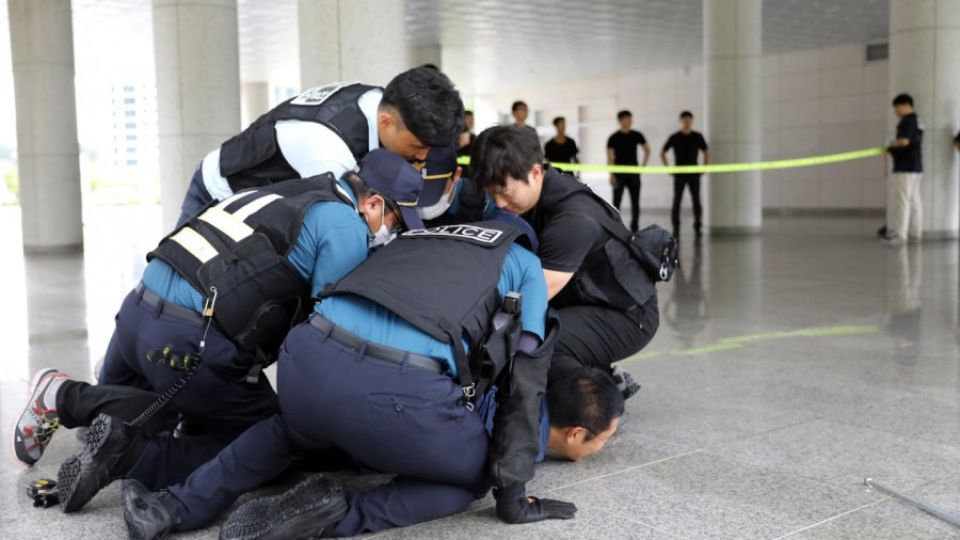August 30, 2023
SEOUL – Tens of thousands of South Korea’s police officers dedicated to crime deterrence and the patrolling of neighborhoods will be armed with new less-lethal handguns, as part of nationwide efforts to curb crimes without obvious motives, President Yoon Suk Yeol said at a Cabinet meeting on Tuesday.
The government expects the new measures to help law enforcement strengthen policing efforts, while serving as an alternative to conventional weapons to avoid police brutality.
“All of the police officers undertaking high-visibility operations will be equipped with low-risk handguns,” Yoon said in a speech during the meeting in his office in Yongsan, Seoul.
According to the budget proposal unveiled Tuesday, some 8.6 billion won ($6.5 million) will be spent to implement the plan to supply the less-lethal weapons to police.
Police spent 3.4 billion won over the course of five years to 2021 to develop what are locally dubbed “low-risk handguns.” According to the presidential office, these handguns are 20 percent lighter than a typical .38 Special Smith & Wesson revolver. When using plastic rubber bullets, the new handguns’ kinetic power amounts to one-tenth that of the .38, though it can also fire blanks and 9-millimeter bullets.
Actual revolvers have already been distributed to some 22,000 officers deployed on the streets for patrolling or in other public safety roles across the nation, and nearly 30,000 additional officers will be provided with less-lethal weapons, according to an official at the Korean National Police Agency.
Deployment of the less-lethal handguns will begin in the latter half of next year, with distribution of the handguns to be completed within three years, while regulations to ban the use of actual bullets in them will be prepared before deployment begins, according to the KNPA.
The decision will allow the Korean police to have three options when dispatched to the scene: a .38 revolver, the low-risk handgun and a Taser.
Yoon has labeled the less-lethal handguns a “fundamental measure” to respond to “mudjima” — or seemingly motiveless “don’t ask why” — crimes. Yoon also suggested a reorganization of law enforcement with an emphasis on stronger presence of police for the safety of communities, as well as the deployment of police training simulators utilizing virtual reality.
A spending package of 1.1 trillion won on the same day was proposed by the government for 2024, up fourfold from this year, to enhance pangovernmental capabilities to tame the surge of crimes.
For example, the provision of equipment like stab-proof vests and expandable batons to 101 riot police units in Korea will cost the government 1.6 billion won.
Moreover, some 73.2 billion won will be spent to help people in urgent need or with severe mental illnesses to get better access to mental health treatment as well as to trigger the early detection of mental illnesses, and bring such patients under government control. Korea is seeing a lack of oversight over patients suffering from severe mental illnesses as among the contributing factors behind the recent surge in serious crimes.
Last week, Prime Minister Han Duck-soo hinted at reviving the conscripted police system, which was phased out in late 2021 and abolished in May, amid weakening crime prevention capabilities in the country. According to police data compiled by the Supreme Prosecutors’ Office, reports of serious violent crimes — homicide, robbery, arson and rape — surged about 30 percent from 2013 to 2022.
Meanwhile, the national budget will also be spent on the welfare of Korean soldiers, including barrack amelioration and pay hikes. Yoon said the improvement of the quality of welfare “has to do with the matter of the national security.”
By 2024, all enlisted soldiers will see their pay increase by 350,000 won per month — including salary and subsidies combined. As a result, an army sergeant, for example, will earn a combined 1.65 million won a month. To achieve this, a budget of about 4.2 trillion won was proposed Tuesday.
Ultimately, an army sergeant will be paid 2.05 million won in monthly salary and subsidies combined beginning in 2025.


